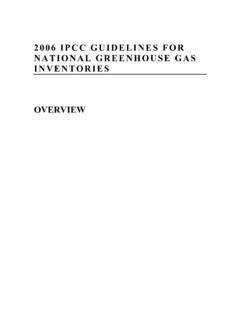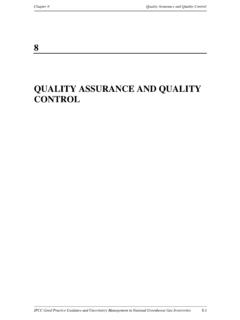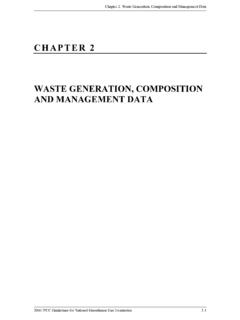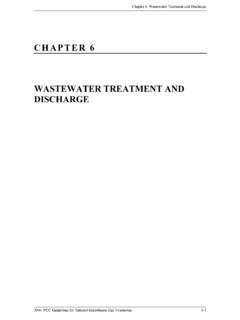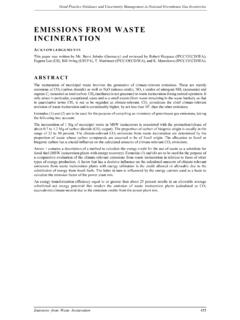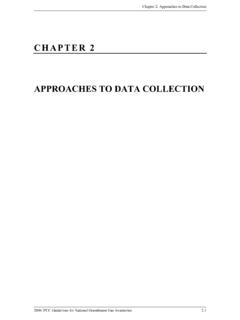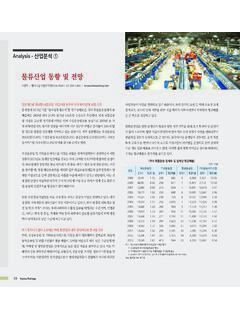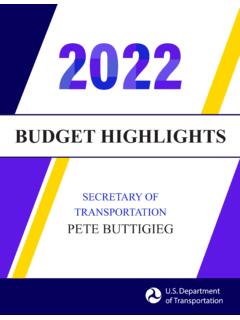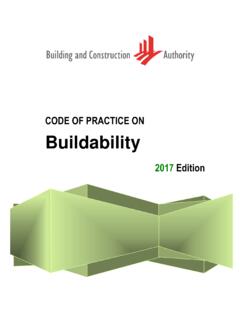Transcription of 2006 IPCC GUIDELINES FOR NATIONAL GREENHOUSE GAS …
1 2006 IPCC GUIDELINES FOR NATIONAL GREENHOUSE GAS INVENTORIES2 Supporting material prepared for consideration by the Intergovernmental Panel on Climate Change (IPCC). This supporting material has not been subject to formal IPCC review report was finalised at the IPCC meeting on the Promotion of the IPCC GUIDELINES held in Geneva, October 2007. The IPCC would like to thank all the participants for their the information in this document is believed to be true and accurate at the date of going to press, neither the authors nor the publishers can accept any legal responsibility or liability for any errors or omissions. Neither the authors nor the publishers have any responsibility for the persistence of any URLs referred to in this report and cannot guarantee that any content of such web sites is or will remain accurate or by the Institute for Global Environmental Strategies (IGES), Hayama, Japan on behalf of the IPCC The Intergovernmental Panel on Climate Change (IPCC), cite as:IPCC 2008, 2006 IPCC GUIDELINES for NATIONAL GREENHOUSE Gas Inventories A primer, Prepared by the NATIONAL GREENHOUSE Gas Inventories Programme, Eggleston , Miwa K.
2 , Srivastava N. and Tanabe K. (eds). Published: IGES, Japan. IPCC NATIONAL GREENHOUSE Gas Inventories ProgrammeTechnical Support Unitc/o Institute for Global Environmental Strategies2108 -11, KamiyamaguchiHayama, KanagawaJAPAN, 240-0115 Fax: (81 46) 855 3808 in Japan2006 IPCC GUIDELINES FOR NATIONAL GREENHOUSE GAS INVENTORIES3 CONTENTSINTRODUCTION ..5 IPCC GUIDELINES and the UNFCCC ..5 Improvements ..5 USING THE 2006 GUIDELINES ..6 Elements of GREENHOUSE Gas Inventories ..6 Anthropogenic ..6 GREENHOUSE gases ..6 Geographic area ..7 Time: Inventory year and time series ..7 Sectors and categories ..7 Inventory Process and Management ..7 Structure of the GUIDELINES ..8 Good Practice: How to ensure a quality inventory ..9 Inventory quality ..9 Compiling an inventory ..10 Step-by-step Inventory Compilation ..12 TRANSITION FROM THE 1996 GUIDELINES ..15 General Issues ..15 Structural changes ..15 Improved general guidance.
3 15 New gases and sources ..15 Estimation of actual annual emissions ..15 Direct CO2 ..16 Indirect Dioxide Capture and Storage ..16 Non-Energy Uses of fossil fuels ..17 AFOLU - Consolidation of previously optional categories ..17 Harvested Wood Products ..17 Wetlands ..17 Changes in Categorisation ..17 Energy ..18 IPPU ..18 AFOLU ..19 Waste ..20 Other ..20 References ..202006 IPCC GUIDELINES FOR NATIONAL GREENHOUSE GAS INVENTORIES5 INTRODUCTIONThis paper introduces the 2006 IPCC GUIDELINES for NATIONAL GREENHOUSE Gas Inventories (2006 GUIDELINES ; IPCC 2006), summarises the basic approach for inventory development, and provides guidance on their use. It is hoped this will give a better understanding of GREENHOUSE gas inventories to a wider 2006 GUIDELINES represent a significant step forward in producing reliable, accurate, consistent and comparable inventories of emissions and removals of GREENHOUSE gases.
4 The 2006 GUIDELINES update earlier guidance, combine good practice guidance and new scientific and technical information on emissions and removals of GREENHOUSE 2006 GUIDELINES provide methodologies for making estimates of NATIONAL anthropogenic emissions and removals of GREENHOUSE gases. These methodologies can be used to assist Parties to the UN Framework Convention on Climate Change (UNFCCC) in fulfilling their commitments to develop inventories of anthropogenic emissions and removals of GREENHOUSE gases not controlled by the Montreal Protocol. Emission inventories are not just needed for reporting emissions and removals; they are also essential tools in developing policies and in monitoring the impact of those policies. As such they provide invaluable information for those developing policies related to climate change and air GUIDELINES and the UNFCCCP arties to the UNFCCC have agreed (amongst other things) to Develop, periodically update, publish and make available.
5 NATIONAL inventories of anthropogenic emissions by sources and removals by sinks of all GREENHOUSE gases not controlled by the Montreal Protocol, using comparable methodologies to be agreed upon by the Conference of the Parties; (UNFCCC 1992). The comparable methodologies agreed on are those produced by the Intergovernmental Panel on Climate Change (IPCC).The Revised 1996 GUIDELINES for NATIONAL GREENHOUSE Gas Inventories (Revised 1996 GUIDELINES , IPCC 1997), together with the two volumes on inventory good practice guidance - the Good Practice Guidance and Uncertainty Management in NATIONAL GREENHOUSE Gas Inventories (GPG 2000 , IPCC 2000 ) and the Good Practice Guidance for Land Use, Land-Use Change and Forestry (GPG-LULUCF, IPCC 2003)-, are to be used by Parties included in Annex I of the UNFCCC (Annex I Parties, developed countries) while the Good Practice Guidance reports are encouraged for use by Parties not included in Annex I of the UNFCCC (Non-Annex I Parties).
6 The 2006 GUIDELINES were produced at the invitation of the UNFCCC in 2002 to update the Revised 1996 GUIDELINES and associated good practice guidance in 2006. The IPCC s Task Force on Inventories undertook this task and the IPCC Panel XXV (Port Louis, Mauritius, April 2006) adopted and accepted the 2006 GUIDELINES . The UNFCCC is currently considering the use of the 2006 GUIDELINES . The 2006 GUIDELINES are a repository of the best available, peer-reviewed parameters and methods for NATIONAL GREENHOUSE gas inventories. These methods and parameters can also be used within the structure of the previous 2006 GUIDELINES are the work of over 250 authors nominated by governments and international organisations and selected in accordance with the IPCC procedures. The final list of authors was selected to ensure as wide a geographic representation as possible as well as to ensure sufficient coverage of all potential sources.
7 Sectoral meetings were held enabling authors to discuss and agree common approaches, followed by drafting and email exchanges to produce the completed GUIDELINES . Following drafting, the complete document was peer reviewed twice, first by experts alone and the second time by experts and governments. After each review an expert meeting considered the comments and, if necessary, edited the text. In all over 6,000 comments were received. Following a period of government consideration the final draft was adopted and accepted by the IPCC in April 2006 GUIDELINES are the most up-to-date guidance available to inventory compilers. They are the latest in a series of publications started in 1995 and built on the earlier guidance. The 2006 GUIDELINES provide users with a number of key advantages compared to earlier guidance: Improved accuracy: The GUIDELINES now include updated methods and improved default values based on up-to-date information thus improving the overall accuracy of estimates.
8 Guidance for all sources and sinks now gives actual annual estimates, as opposed to the earlier potential methods. More complete: Guidance is given on more sources and sinks as they have been identified since 1996. Guidance on land use sectors has been made more complete and consistent across all land uses. More fluorinated GREENHOUSE gases are included as information on their 2006 IPCC GUIDELINES FOR NATIONAL GREENHOUSE GAS INVENTORIES6use and release has become available. Reduced scope for errors: The source categories have been restructured to reduce the possibilities for double counting or omissions. The most appropriate choice of method has been made easier by incorporating and updating the earlier good practice guidance into the individual sector methods. Clearer guidance: Integrating all the good practice guidance into the methodology report ensures that users can more easily find all the relevant information they need.
9 The guidance starts with one general volume on overall QA/QC and good practice issues and sector-specific matters are all dealt with in the sector volumes. Resource-relevant methods: Differing methodologies and their selection enable inventory developers with limited resources to complete their NATIONAL estimates while also allowing those with greater resources to use more detailed and accurate THE 2006 GUIDELINESThis section explains the approach in the 2006 GUIDELINES to estimating emissions and removals of GREENHOUSE gases. It starts by providing some key definitions, then outlines the inventory process and describes how inventories should be managed. The final part is a step-by-step description of compiling an of GREENHOUSE Gas Inventories GREENHOUSE gas inventories are estimates of all the anthropogenic emissions and removals of specified gases from all categories and sectors from a given area during a specified time frame.
10 These parameters need to be clearly defined in order for inventories to be consistent and emissions and removals means that GREENHOUSE gas emissions and removals included in NATIONAL inventories are a result of human activities. The distinction between natural and anthropogenic emissions and removals follows straightforwardly from the data used to quantify human activity. In the Agriculture, Forestry and Other Land Use (AFOLU) Sector, emissions and removals on managed land are taken as a proxy for anthropogenic emissions and removals. Inter-annual variations in natural background emissions and removals, though these can be significant, are assumed to average out over gasesThe gases that contribute to climate change have been identified in IPCC assessment reports. While previous IPCC guidance focused on the gases with Global Warming Potentials (GWPs) identified in the Second Assessment Report (IPCC 1995a; IPCC 1995b), the 2006 GUIDELINES cover a longer list of GREENHOUSE gases with GWP values identified in the Third Assessment Report (IPCC 2001a; IPCC 2001b) or potential replacements for them (see Table 1).
